Human Resource Development Report and Analysis for Sun Court Ltd
VerifiedAdded on 2020/06/06
|18
|5241
|56
Report
AI Summary
This report delves into the realm of Human Resource Development (HRD), examining various learning styles, including Kolb's and Honey and Mumford's models, and their impact on employee development within Sun Court Ltd. It explores different training needs at various organizational levels and assesses the advantages and disadvantages of diverse training methods. The report also outlines a systematic approach to planning training, including an evaluation plan and a review of the success of evaluation methods. Furthermore, it discusses the role of government in training and lifelong learning, the competency movement's influence, and the contribution of contemporary theory within the context of Sun Court Ltd, offering a comprehensive analysis of HRD practices.

HUMAN RESOURCE
DEVELOPMENT
DEVELOPMENT
Paraphrase This Document
Need a fresh take? Get an instant paraphrase of this document with our AI Paraphraser

Table of Contents
INTRODUCTION...........................................................................................................................3
TASK 1............................................................................................................................................3
1.1 Different learning styles...................................................................................................3
TASK 2............................................................................................................................................5
2.1 Training needs at different levels.....................................................................................5
2.2 Different training methods, their positives and negatives................................................6
2.3 Systematic approach for planning training.......................................................................7
Task 2...............................................................................................................................................8
3.1 Evaluation plan for training..............................................................................................8
3.2 Evaluation of training on the basis of techniques used....................................................9
3.3 Review of success of evaluation method used.................................................................9
TASK 4..........................................................................................................................................10
4.1 Role of government in training and life long learning...................................................10
4.2 Competency movement and its impacted on the public and private sector...................11
4.3 Contribution of contemporary theory in Sun Court ltd..................................................11
CONCLUSION..............................................................................................................................12
REFERENCES..............................................................................................................................13
INTRODUCTION...........................................................................................................................3
TASK 1............................................................................................................................................3
1.1 Different learning styles...................................................................................................3
TASK 2............................................................................................................................................5
2.1 Training needs at different levels.....................................................................................5
2.2 Different training methods, their positives and negatives................................................6
2.3 Systematic approach for planning training.......................................................................7
Task 2...............................................................................................................................................8
3.1 Evaluation plan for training..............................................................................................8
3.2 Evaluation of training on the basis of techniques used....................................................9
3.3 Review of success of evaluation method used.................................................................9
TASK 4..........................................................................................................................................10
4.1 Role of government in training and life long learning...................................................10
4.2 Competency movement and its impacted on the public and private sector...................11
4.3 Contribution of contemporary theory in Sun Court ltd..................................................11
CONCLUSION..............................................................................................................................12
REFERENCES..............................................................................................................................13

INTRODUCTION
Human resource development is a process through which skills of employees are
developed. It is a continuous process which is followed in every business in order to increase the
efficiency and productivity of an enterprise. Sun Court ltd is a nursing home which is
established in different parts of country and having a very big business. The following report is
prepared in order to understand what are the different advantages of gaining knowledge in
organisation and how it contributes in increasing profitability of the same enterprise (Brushett
and et.al., 2010). Different methods and techniques of learning are discussed in detail in order to
understand how they are utilised in the cited business entity.
TASK 1
1.1 Compare different learning styles
Kolb's Honey and Mumford’s
Hold concrete education Look for opportunities For learning
Accommodators
Diverges
Assimilators
Converges
Pragmatist
Activist
Reflector
Theorist
Based on learning cycle Based Upon Kolbs's work
Honey and Mumford has focused on the four types of learning approaches that persons
naturally chooses and they suggest that in order to maximize one's own individual learning.
Individual have different mind-set to perceive the knowledge in the effective way. Every
individual learn differently because they have their own learning styles. Learning can be done
when individual watch something or someone and some people learn by doing some activities
and operations. Every individual do not have fix learning styles, it may varies from situation to
Human resource development is a process through which skills of employees are
developed. It is a continuous process which is followed in every business in order to increase the
efficiency and productivity of an enterprise. Sun Court ltd is a nursing home which is
established in different parts of country and having a very big business. The following report is
prepared in order to understand what are the different advantages of gaining knowledge in
organisation and how it contributes in increasing profitability of the same enterprise (Brushett
and et.al., 2010). Different methods and techniques of learning are discussed in detail in order to
understand how they are utilised in the cited business entity.
TASK 1
1.1 Compare different learning styles
Kolb's Honey and Mumford’s
Hold concrete education Look for opportunities For learning
Accommodators
Diverges
Assimilators
Converges
Pragmatist
Activist
Reflector
Theorist
Based on learning cycle Based Upon Kolbs's work
Honey and Mumford has focused on the four types of learning approaches that persons
naturally chooses and they suggest that in order to maximize one's own individual learning.
Individual have different mind-set to perceive the knowledge in the effective way. Every
individual learn differently because they have their own learning styles. Learning can be done
when individual watch something or someone and some people learn by doing some activities
and operations. Every individual do not have fix learning styles, it may varies from situation to
⊘ This is a preview!⊘
Do you want full access?
Subscribe today to unlock all pages.

Trusted by 1+ million students worldwide

situation. This is because every situation have different criteria to do that, if the activity is
simple, it can be learned by just watching it and if the activity is complex it cannot be learned by
just watching, individual need to do that practically so that he can lean it easily (Abreu and et.
al., 2011). Traditionally theoretical and logical teaching methods based on books are used. But
now learning is required both practical and logical methods. Different learning styles helps the
person to learn different operation quickly as well as helps them to remind it for future. Different
learning styles are as follows:
Learning styles Characteristics Activities
Visual learning These learners mainly prefer gaining information or
learning through the charts, diagram, flowchart or
images.
Images
Flow charts
Auditory learning Under this style learners learn best by attending
lectures, seminars or group discussion.
Lectures
Kinesthetic
learning
Learners selecting this style prefer learning through
doing and touching even the learners expresses
themselves through the movement.
Acting
Visual learning styles: It is the learning style where person can learn different things by
just watching someone or some things. It is kind of tutorial learning where person can understand
different things by just watching tutorial. In this learning style pictures, images, diagrams,
presentations, short films, mind maps and other visual elements can be used to help person to
learn things perfectly
Aural learning styles: This style is completely different from the visual learning, here
individual learn different things by just hearing different things such as recordings, music,
poems, rhythms, etc (Abreu and et. al., 2012).
Verbal learning styles: This style includes all the ways which consist in speaking. The
person who is good in this learning style can become teach so that he can explain different things
by teaching students verbally. This includes notes, scripts etc.
Physical learning style: This is the learning style where people learn different things by
doing some activities with the help of their hands, legs, body and sense of touch.
Logical learning styles: In this style theories, logics, reasoning and systems are used by
the person in order to learn different things in his or her personal or professional life.
simple, it can be learned by just watching it and if the activity is complex it cannot be learned by
just watching, individual need to do that practically so that he can lean it easily (Abreu and et.
al., 2011). Traditionally theoretical and logical teaching methods based on books are used. But
now learning is required both practical and logical methods. Different learning styles helps the
person to learn different operation quickly as well as helps them to remind it for future. Different
learning styles are as follows:
Learning styles Characteristics Activities
Visual learning These learners mainly prefer gaining information or
learning through the charts, diagram, flowchart or
images.
Images
Flow charts
Auditory learning Under this style learners learn best by attending
lectures, seminars or group discussion.
Lectures
Kinesthetic
learning
Learners selecting this style prefer learning through
doing and touching even the learners expresses
themselves through the movement.
Acting
Visual learning styles: It is the learning style where person can learn different things by
just watching someone or some things. It is kind of tutorial learning where person can understand
different things by just watching tutorial. In this learning style pictures, images, diagrams,
presentations, short films, mind maps and other visual elements can be used to help person to
learn things perfectly
Aural learning styles: This style is completely different from the visual learning, here
individual learn different things by just hearing different things such as recordings, music,
poems, rhythms, etc (Abreu and et. al., 2012).
Verbal learning styles: This style includes all the ways which consist in speaking. The
person who is good in this learning style can become teach so that he can explain different things
by teaching students verbally. This includes notes, scripts etc.
Physical learning style: This is the learning style where people learn different things by
doing some activities with the help of their hands, legs, body and sense of touch.
Logical learning styles: In this style theories, logics, reasoning and systems are used by
the person in order to learn different things in his or her personal or professional life.
Paraphrase This Document
Need a fresh take? Get an instant paraphrase of this document with our AI Paraphraser
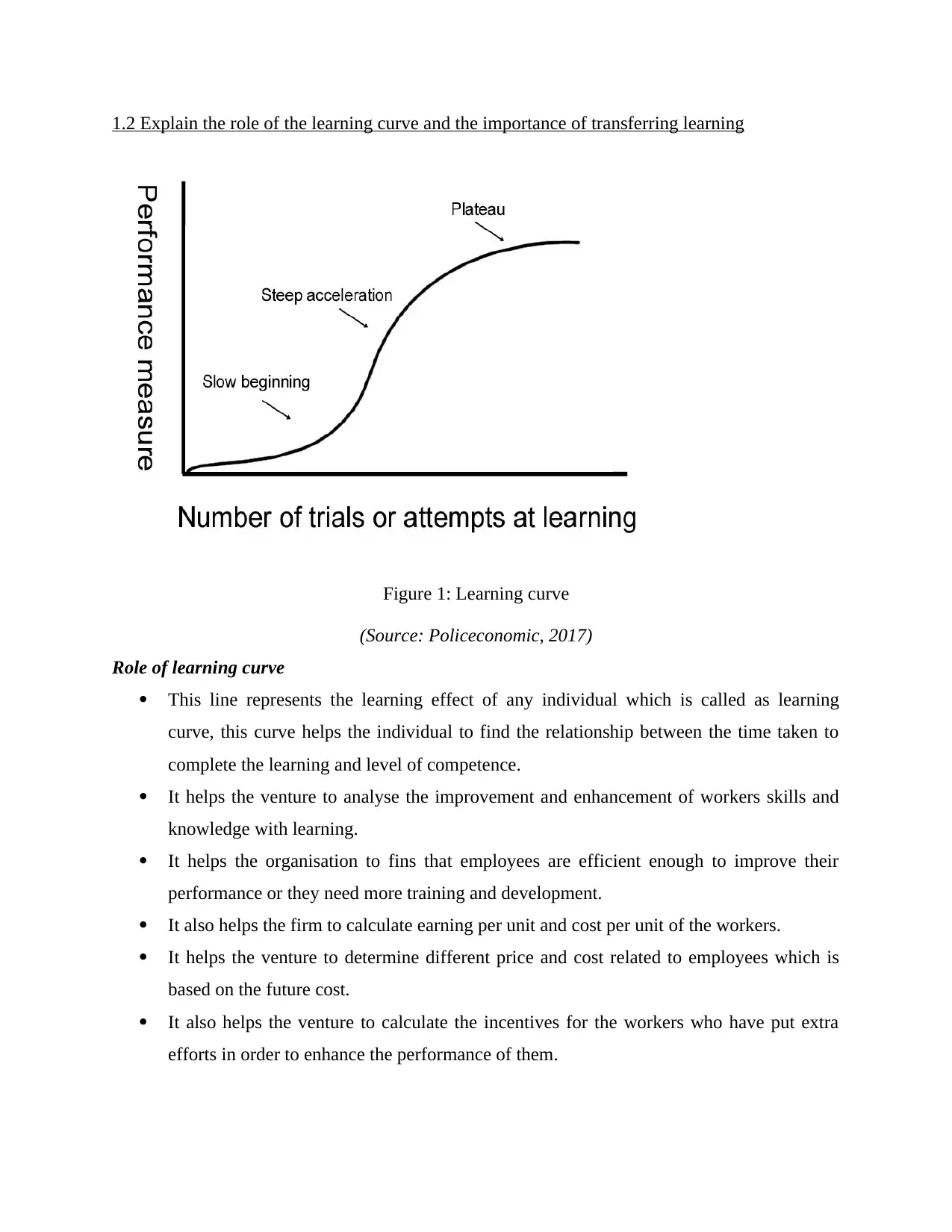
1.2 Explain the role of the learning curve and the importance of transferring learning
Figure 1: Learning curve
(Source: Policeconomic, 2017)
Role of learning curve
This line represents the learning effect of any individual which is called as learning
curve, this curve helps the individual to find the relationship between the time taken to
complete the learning and level of competence.
It helps the venture to analyse the improvement and enhancement of workers skills and
knowledge with learning.
It helps the organisation to fins that employees are efficient enough to improve their
performance or they need more training and development.
It also helps the firm to calculate earning per unit and cost per unit of the workers.
It helps the venture to determine different price and cost related to employees which is
based on the future cost.
It also helps the venture to calculate the incentives for the workers who have put extra
efforts in order to enhance the performance of them.
Figure 1: Learning curve
(Source: Policeconomic, 2017)
Role of learning curve
This line represents the learning effect of any individual which is called as learning
curve, this curve helps the individual to find the relationship between the time taken to
complete the learning and level of competence.
It helps the venture to analyse the improvement and enhancement of workers skills and
knowledge with learning.
It helps the organisation to fins that employees are efficient enough to improve their
performance or they need more training and development.
It also helps the firm to calculate earning per unit and cost per unit of the workers.
It helps the venture to determine different price and cost related to employees which is
based on the future cost.
It also helps the venture to calculate the incentives for the workers who have put extra
efforts in order to enhance the performance of them.
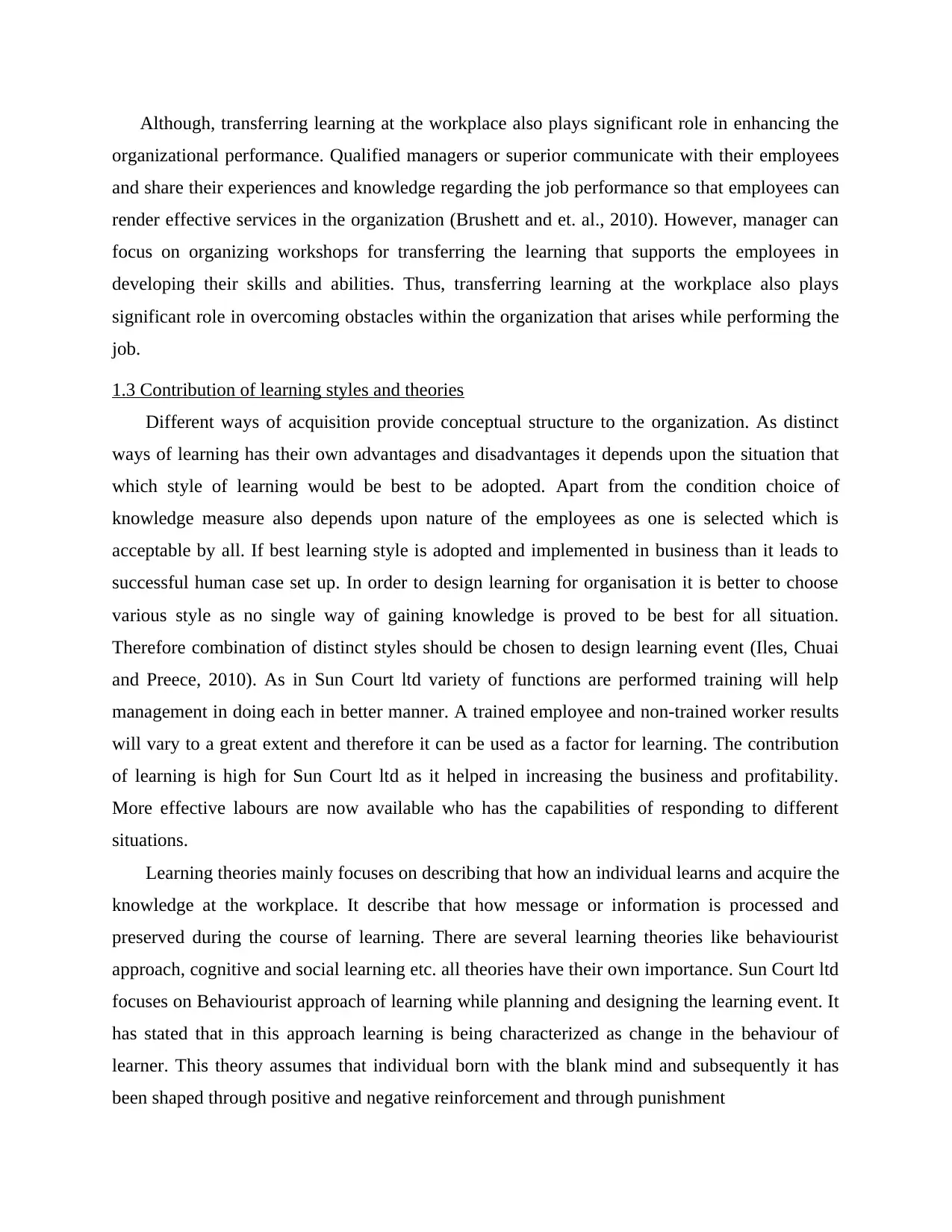
Although, transferring learning at the workplace also plays significant role in enhancing the
organizational performance. Qualified managers or superior communicate with their employees
and share their experiences and knowledge regarding the job performance so that employees can
render effective services in the organization (Brushett and et. al., 2010). However, manager can
focus on organizing workshops for transferring the learning that supports the employees in
developing their skills and abilities. Thus, transferring learning at the workplace also plays
significant role in overcoming obstacles within the organization that arises while performing the
job.
1.3 Contribution of learning styles and theories
Different ways of acquisition provide conceptual structure to the organization. As distinct
ways of learning has their own advantages and disadvantages it depends upon the situation that
which style of learning would be best to be adopted. Apart from the condition choice of
knowledge measure also depends upon nature of the employees as one is selected which is
acceptable by all. If best learning style is adopted and implemented in business than it leads to
successful human case set up. In order to design learning for organisation it is better to choose
various style as no single way of gaining knowledge is proved to be best for all situation.
Therefore combination of distinct styles should be chosen to design learning event (Iles, Chuai
and Preece, 2010). As in Sun Court ltd variety of functions are performed training will help
management in doing each in better manner. A trained employee and non-trained worker results
will vary to a great extent and therefore it can be used as a factor for learning. The contribution
of learning is high for Sun Court ltd as it helped in increasing the business and profitability.
More effective labours are now available who has the capabilities of responding to different
situations.
Learning theories mainly focuses on describing that how an individual learns and acquire the
knowledge at the workplace. It describe that how message or information is processed and
preserved during the course of learning. There are several learning theories like behaviourist
approach, cognitive and social learning etc. all theories have their own importance. Sun Court ltd
focuses on Behaviourist approach of learning while planning and designing the learning event. It
has stated that in this approach learning is being characterized as change in the behaviour of
learner. This theory assumes that individual born with the blank mind and subsequently it has
been shaped through positive and negative reinforcement and through punishment
organizational performance. Qualified managers or superior communicate with their employees
and share their experiences and knowledge regarding the job performance so that employees can
render effective services in the organization (Brushett and et. al., 2010). However, manager can
focus on organizing workshops for transferring the learning that supports the employees in
developing their skills and abilities. Thus, transferring learning at the workplace also plays
significant role in overcoming obstacles within the organization that arises while performing the
job.
1.3 Contribution of learning styles and theories
Different ways of acquisition provide conceptual structure to the organization. As distinct
ways of learning has their own advantages and disadvantages it depends upon the situation that
which style of learning would be best to be adopted. Apart from the condition choice of
knowledge measure also depends upon nature of the employees as one is selected which is
acceptable by all. If best learning style is adopted and implemented in business than it leads to
successful human case set up. In order to design learning for organisation it is better to choose
various style as no single way of gaining knowledge is proved to be best for all situation.
Therefore combination of distinct styles should be chosen to design learning event (Iles, Chuai
and Preece, 2010). As in Sun Court ltd variety of functions are performed training will help
management in doing each in better manner. A trained employee and non-trained worker results
will vary to a great extent and therefore it can be used as a factor for learning. The contribution
of learning is high for Sun Court ltd as it helped in increasing the business and profitability.
More effective labours are now available who has the capabilities of responding to different
situations.
Learning theories mainly focuses on describing that how an individual learns and acquire the
knowledge at the workplace. It describe that how message or information is processed and
preserved during the course of learning. There are several learning theories like behaviourist
approach, cognitive and social learning etc. all theories have their own importance. Sun Court ltd
focuses on Behaviourist approach of learning while planning and designing the learning event. It
has stated that in this approach learning is being characterized as change in the behaviour of
learner. This theory assumes that individual born with the blank mind and subsequently it has
been shaped through positive and negative reinforcement and through punishment
⊘ This is a preview!⊘
Do you want full access?
Subscribe today to unlock all pages.

Trusted by 1+ million students worldwide
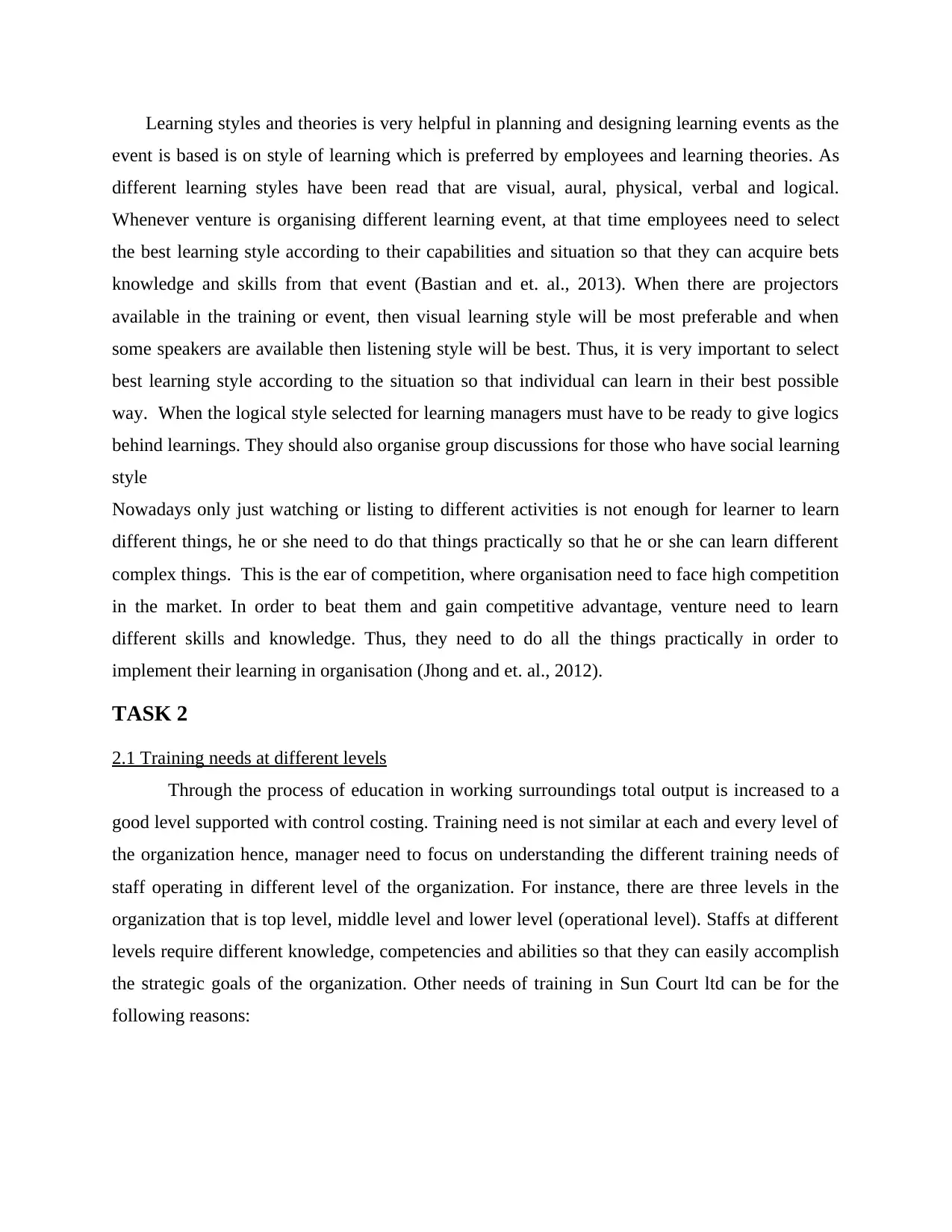
Learning styles and theories is very helpful in planning and designing learning events as the
event is based is on style of learning which is preferred by employees and learning theories. As
different learning styles have been read that are visual, aural, physical, verbal and logical.
Whenever venture is organising different learning event, at that time employees need to select
the best learning style according to their capabilities and situation so that they can acquire bets
knowledge and skills from that event (Bastian and et. al., 2013). When there are projectors
available in the training or event, then visual learning style will be most preferable and when
some speakers are available then listening style will be best. Thus, it is very important to select
best learning style according to the situation so that individual can learn in their best possible
way. When the logical style selected for learning managers must have to be ready to give logics
behind learnings. They should also organise group discussions for those who have social learning
style
Nowadays only just watching or listing to different activities is not enough for learner to learn
different things, he or she need to do that things practically so that he or she can learn different
complex things. This is the ear of competition, where organisation need to face high competition
in the market. In order to beat them and gain competitive advantage, venture need to learn
different skills and knowledge. Thus, they need to do all the things practically in order to
implement their learning in organisation (Jhong and et. al., 2012).
TASK 2
2.1 Training needs at different levels
Through the process of education in working surroundings total output is increased to a
good level supported with control costing. Training need is not similar at each and every level of
the organization hence, manager need to focus on understanding the different training needs of
staff operating in different level of the organization. For instance, there are three levels in the
organization that is top level, middle level and lower level (operational level). Staffs at different
levels require different knowledge, competencies and abilities so that they can easily accomplish
the strategic goals of the organization. Other needs of training in Sun Court ltd can be for the
following reasons:
event is based is on style of learning which is preferred by employees and learning theories. As
different learning styles have been read that are visual, aural, physical, verbal and logical.
Whenever venture is organising different learning event, at that time employees need to select
the best learning style according to their capabilities and situation so that they can acquire bets
knowledge and skills from that event (Bastian and et. al., 2013). When there are projectors
available in the training or event, then visual learning style will be most preferable and when
some speakers are available then listening style will be best. Thus, it is very important to select
best learning style according to the situation so that individual can learn in their best possible
way. When the logical style selected for learning managers must have to be ready to give logics
behind learnings. They should also organise group discussions for those who have social learning
style
Nowadays only just watching or listing to different activities is not enough for learner to learn
different things, he or she need to do that things practically so that he or she can learn different
complex things. This is the ear of competition, where organisation need to face high competition
in the market. In order to beat them and gain competitive advantage, venture need to learn
different skills and knowledge. Thus, they need to do all the things practically in order to
implement their learning in organisation (Jhong and et. al., 2012).
TASK 2
2.1 Training needs at different levels
Through the process of education in working surroundings total output is increased to a
good level supported with control costing. Training need is not similar at each and every level of
the organization hence, manager need to focus on understanding the different training needs of
staff operating in different level of the organization. For instance, there are three levels in the
organization that is top level, middle level and lower level (operational level). Staffs at different
levels require different knowledge, competencies and abilities so that they can easily accomplish
the strategic goals of the organization. Other needs of training in Sun Court ltd can be for the
following reasons:
Paraphrase This Document
Need a fresh take? Get an instant paraphrase of this document with our AI Paraphraser
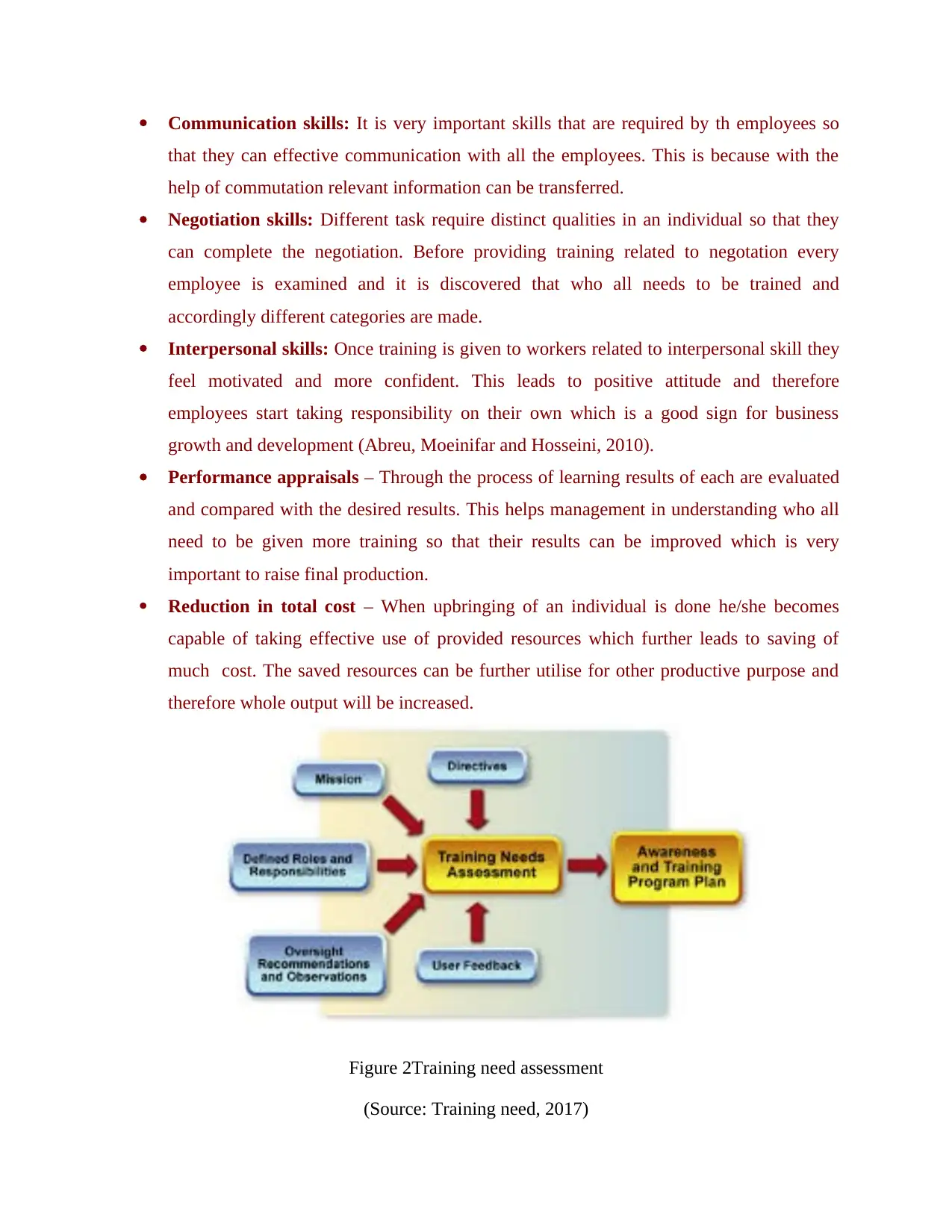
Communication skills: It is very important skills that are required by th employees so
that they can effective communication with all the employees. This is because with the
help of commutation relevant information can be transferred.
Negotiation skills: Different task require distinct qualities in an individual so that they
can complete the negotiation. Before providing training related to negotation every
employee is examined and it is discovered that who all needs to be trained and
accordingly different categories are made.
Interpersonal skills: Once training is given to workers related to interpersonal skill they
feel motivated and more confident. This leads to positive attitude and therefore
employees start taking responsibility on their own which is a good sign for business
growth and development (Abreu, Moeinifar and Hosseini, 2010).
Performance appraisals – Through the process of learning results of each are evaluated
and compared with the desired results. This helps management in understanding who all
need to be given more training so that their results can be improved which is very
important to raise final production.
Reduction in total cost – When upbringing of an individual is done he/she becomes
capable of taking effective use of provided resources which further leads to saving of
much cost. The saved resources can be further utilise for other productive purpose and
therefore whole output will be increased.
Figure 2Training need assessment
(Source: Training need, 2017)
that they can effective communication with all the employees. This is because with the
help of commutation relevant information can be transferred.
Negotiation skills: Different task require distinct qualities in an individual so that they
can complete the negotiation. Before providing training related to negotation every
employee is examined and it is discovered that who all needs to be trained and
accordingly different categories are made.
Interpersonal skills: Once training is given to workers related to interpersonal skill they
feel motivated and more confident. This leads to positive attitude and therefore
employees start taking responsibility on their own which is a good sign for business
growth and development (Abreu, Moeinifar and Hosseini, 2010).
Performance appraisals – Through the process of learning results of each are evaluated
and compared with the desired results. This helps management in understanding who all
need to be given more training so that their results can be improved which is very
important to raise final production.
Reduction in total cost – When upbringing of an individual is done he/she becomes
capable of taking effective use of provided resources which further leads to saving of
much cost. The saved resources can be further utilise for other productive purpose and
therefore whole output will be increased.
Figure 2Training need assessment
(Source: Training need, 2017)
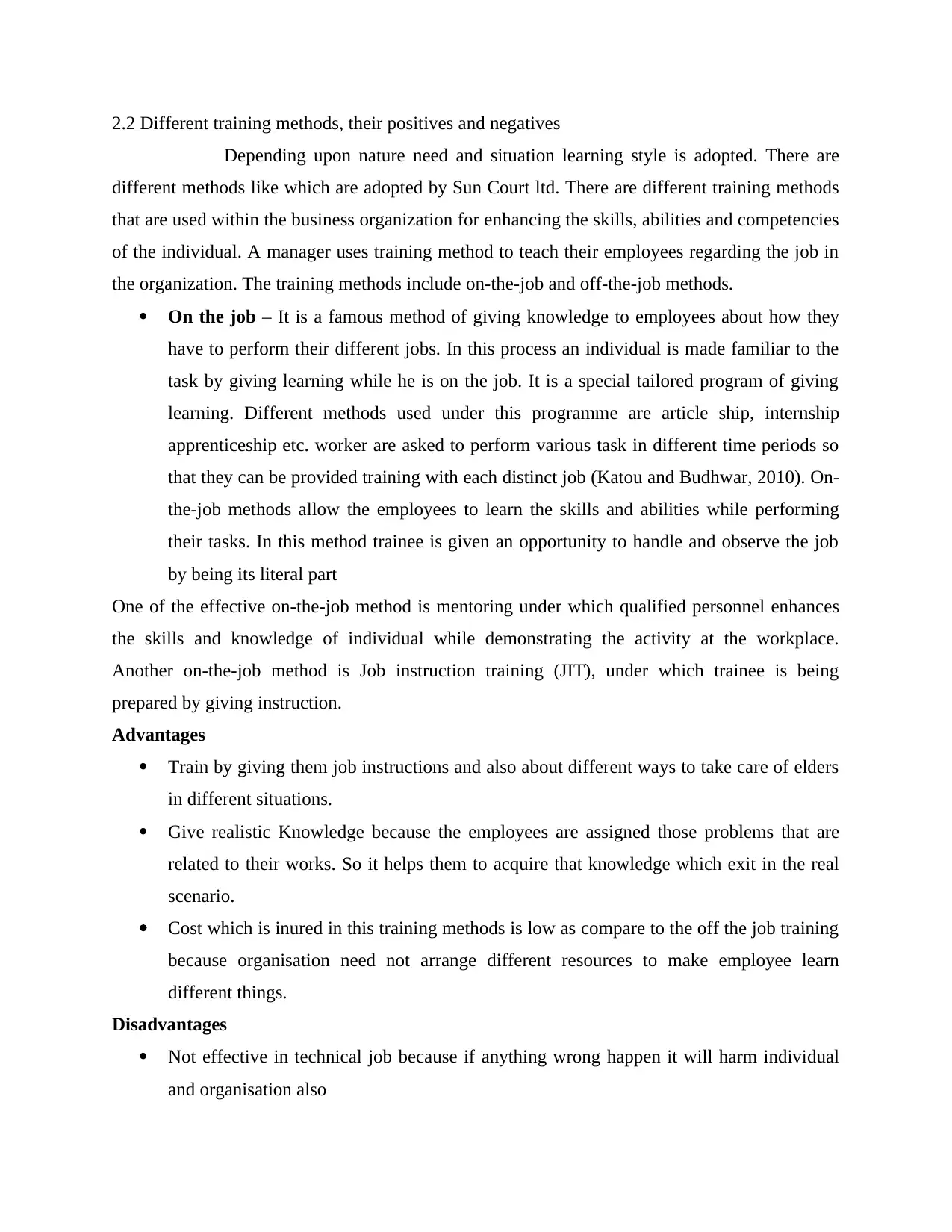
2.2 Different training methods, their positives and negatives
Depending upon nature need and situation learning style is adopted. There are
different methods like which are adopted by Sun Court ltd. There are different training methods
that are used within the business organization for enhancing the skills, abilities and competencies
of the individual. A manager uses training method to teach their employees regarding the job in
the organization. The training methods include on-the-job and off-the-job methods.
On the job – It is a famous method of giving knowledge to employees about how they
have to perform their different jobs. In this process an individual is made familiar to the
task by giving learning while he is on the job. It is a special tailored program of giving
learning. Different methods used under this programme are article ship, internship
apprenticeship etc. worker are asked to perform various task in different time periods so
that they can be provided training with each distinct job (Katou and Budhwar, 2010). On-
the-job methods allow the employees to learn the skills and abilities while performing
their tasks. In this method trainee is given an opportunity to handle and observe the job
by being its literal part
One of the effective on-the-job method is mentoring under which qualified personnel enhances
the skills and knowledge of individual while demonstrating the activity at the workplace.
Another on-the-job method is Job instruction training (JIT), under which trainee is being
prepared by giving instruction.
Advantages
Train by giving them job instructions and also about different ways to take care of elders
in different situations.
Give realistic Knowledge because the employees are assigned those problems that are
related to their works. So it helps them to acquire that knowledge which exit in the real
scenario.
Cost which is inured in this training methods is low as compare to the off the job training
because organisation need not arrange different resources to make employee learn
different things.
Disadvantages
Not effective in technical job because if anything wrong happen it will harm individual
and organisation also
Depending upon nature need and situation learning style is adopted. There are
different methods like which are adopted by Sun Court ltd. There are different training methods
that are used within the business organization for enhancing the skills, abilities and competencies
of the individual. A manager uses training method to teach their employees regarding the job in
the organization. The training methods include on-the-job and off-the-job methods.
On the job – It is a famous method of giving knowledge to employees about how they
have to perform their different jobs. In this process an individual is made familiar to the
task by giving learning while he is on the job. It is a special tailored program of giving
learning. Different methods used under this programme are article ship, internship
apprenticeship etc. worker are asked to perform various task in different time periods so
that they can be provided training with each distinct job (Katou and Budhwar, 2010). On-
the-job methods allow the employees to learn the skills and abilities while performing
their tasks. In this method trainee is given an opportunity to handle and observe the job
by being its literal part
One of the effective on-the-job method is mentoring under which qualified personnel enhances
the skills and knowledge of individual while demonstrating the activity at the workplace.
Another on-the-job method is Job instruction training (JIT), under which trainee is being
prepared by giving instruction.
Advantages
Train by giving them job instructions and also about different ways to take care of elders
in different situations.
Give realistic Knowledge because the employees are assigned those problems that are
related to their works. So it helps them to acquire that knowledge which exit in the real
scenario.
Cost which is inured in this training methods is low as compare to the off the job training
because organisation need not arrange different resources to make employee learn
different things.
Disadvantages
Not effective in technical job because if anything wrong happen it will harm individual
and organisation also
⊘ This is a preview!⊘
Do you want full access?
Subscribe today to unlock all pages.

Trusted by 1+ million students worldwide

It may lead to loss of resources because different resources of the organisation is given to
them and if they not perform in efficient manner, then resources will be waste.
Off the job – In this method trainee is provided with artificial working environment
which is created in a manner that is similar to actual work place. It is adopted for such
jobs where prior training is important to given before placing the employee to real work
place (Moeinifar, Kokabi and Hosseini, 2010).
Advantages
Provide information to trainee about different things out of work, which helps the
workers to learn about internal and external work.
Person can concentrate with full attention because these all activities are new for him or
her.
Disadvantages –
May leads to increase in training cost because new resources need to be allotted, other
than that artificial environment need to be created.
Time consuming method because trainer need to explain all the things and activities
because all the things are new for the trainee.
2.3 Systematic approach for planning training
In order to start learning programme it is advisable to follow a particular plan of
implementation so that best outcomes can be received after the tanning is completed. An
effective programme of giving knowledge should ensure that it will give best results to the
business on completion. Given below is an effective method how learning can be implemented in
Sun Court ltd efficiently:
Analysis – Prime step should be to discover what the needs of training in organisation
are. It can be done through examining performance of different human resources which
can be done through comparing results of employees with those of organisational goals.
If they deviate than is obvious that there is need to improve performance which can be
done through training (Abreu and et.al., 2012).
Design – At this stage all the data collected during the stage of analysing is used as a base
to identify what all resources will be required and how they will be made available.
Location is also decided that where training will take place.
them and if they not perform in efficient manner, then resources will be waste.
Off the job – In this method trainee is provided with artificial working environment
which is created in a manner that is similar to actual work place. It is adopted for such
jobs where prior training is important to given before placing the employee to real work
place (Moeinifar, Kokabi and Hosseini, 2010).
Advantages
Provide information to trainee about different things out of work, which helps the
workers to learn about internal and external work.
Person can concentrate with full attention because these all activities are new for him or
her.
Disadvantages –
May leads to increase in training cost because new resources need to be allotted, other
than that artificial environment need to be created.
Time consuming method because trainer need to explain all the things and activities
because all the things are new for the trainee.
2.3 Systematic approach for planning training
In order to start learning programme it is advisable to follow a particular plan of
implementation so that best outcomes can be received after the tanning is completed. An
effective programme of giving knowledge should ensure that it will give best results to the
business on completion. Given below is an effective method how learning can be implemented in
Sun Court ltd efficiently:
Analysis – Prime step should be to discover what the needs of training in organisation
are. It can be done through examining performance of different human resources which
can be done through comparing results of employees with those of organisational goals.
If they deviate than is obvious that there is need to improve performance which can be
done through training (Abreu and et.al., 2012).
Design – At this stage all the data collected during the stage of analysing is used as a base
to identify what all resources will be required and how they will be made available.
Location is also decided that where training will take place.
Paraphrase This Document
Need a fresh take? Get an instant paraphrase of this document with our AI Paraphraser
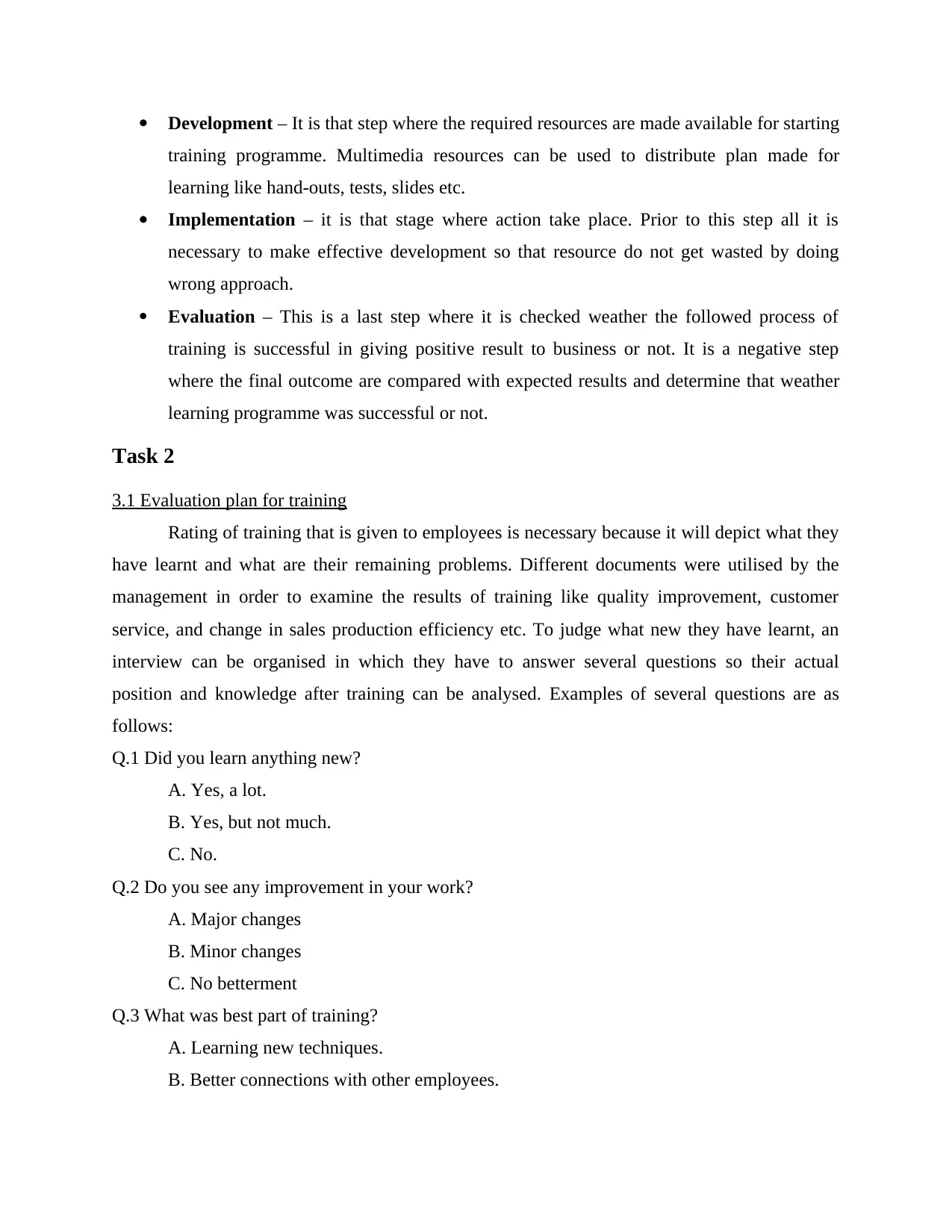
Development – It is that step where the required resources are made available for starting
training programme. Multimedia resources can be used to distribute plan made for
learning like hand-outs, tests, slides etc.
Implementation – it is that stage where action take place. Prior to this step all it is
necessary to make effective development so that resource do not get wasted by doing
wrong approach.
Evaluation – This is a last step where it is checked weather the followed process of
training is successful in giving positive result to business or not. It is a negative step
where the final outcome are compared with expected results and determine that weather
learning programme was successful or not.
Task 2
3.1 Evaluation plan for training
Rating of training that is given to employees is necessary because it will depict what they
have learnt and what are their remaining problems. Different documents were utilised by the
management in order to examine the results of training like quality improvement, customer
service, and change in sales production efficiency etc. To judge what new they have learnt, an
interview can be organised in which they have to answer several questions so their actual
position and knowledge after training can be analysed. Examples of several questions are as
follows:
Q.1 Did you learn anything new?
A. Yes, a lot.
B. Yes, but not much.
C. No.
Q.2 Do you see any improvement in your work?
A. Major changes
B. Minor changes
C. No betterment
Q.3 What was best part of training?
A. Learning new techniques.
B. Better connections with other employees.
training programme. Multimedia resources can be used to distribute plan made for
learning like hand-outs, tests, slides etc.
Implementation – it is that stage where action take place. Prior to this step all it is
necessary to make effective development so that resource do not get wasted by doing
wrong approach.
Evaluation – This is a last step where it is checked weather the followed process of
training is successful in giving positive result to business or not. It is a negative step
where the final outcome are compared with expected results and determine that weather
learning programme was successful or not.
Task 2
3.1 Evaluation plan for training
Rating of training that is given to employees is necessary because it will depict what they
have learnt and what are their remaining problems. Different documents were utilised by the
management in order to examine the results of training like quality improvement, customer
service, and change in sales production efficiency etc. To judge what new they have learnt, an
interview can be organised in which they have to answer several questions so their actual
position and knowledge after training can be analysed. Examples of several questions are as
follows:
Q.1 Did you learn anything new?
A. Yes, a lot.
B. Yes, but not much.
C. No.
Q.2 Do you see any improvement in your work?
A. Major changes
B. Minor changes
C. No betterment
Q.3 What was best part of training?
A. Learning new techniques.
B. Better connections with other employees.
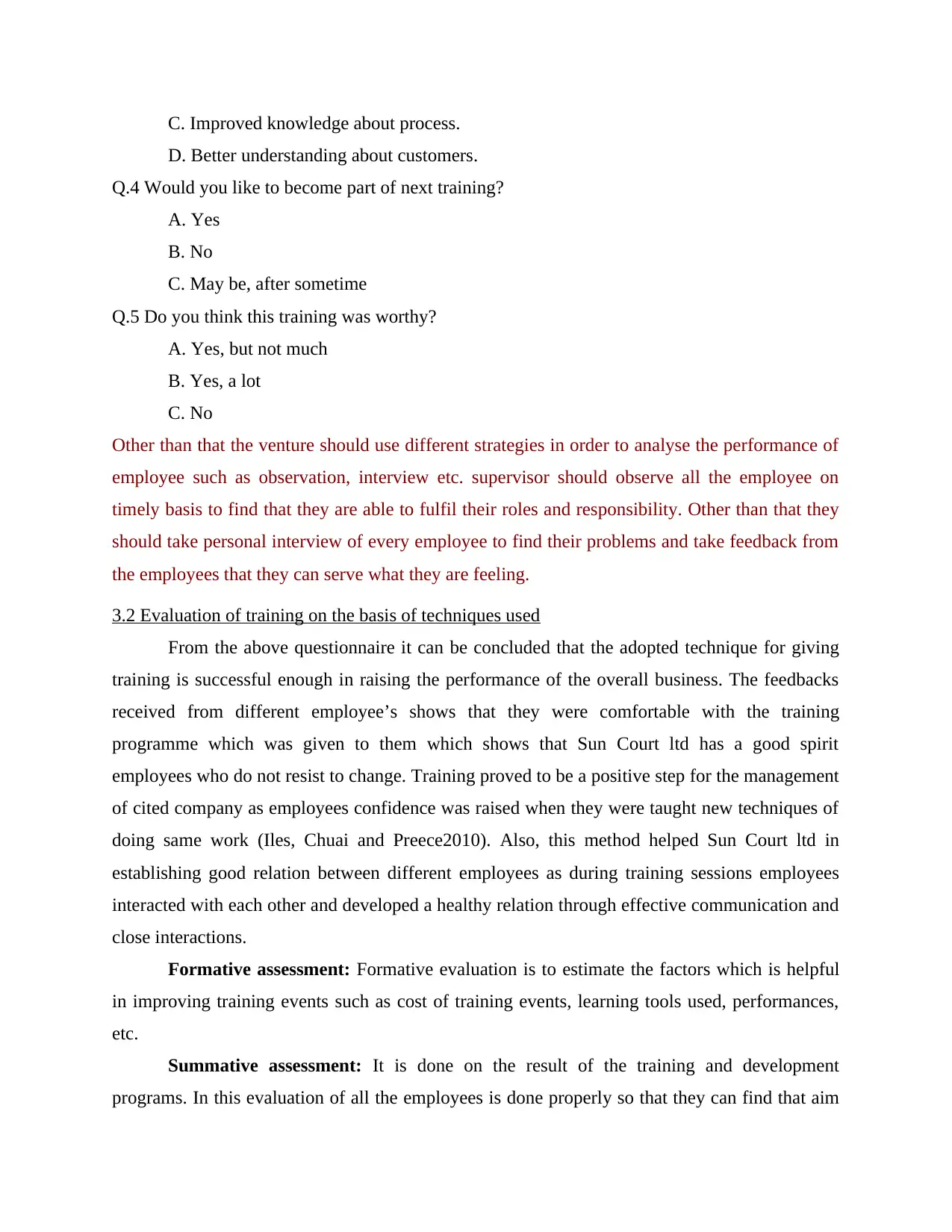
C. Improved knowledge about process.
D. Better understanding about customers.
Q.4 Would you like to become part of next training?
A. Yes
B. No
C. May be, after sometime
Q.5 Do you think this training was worthy?
A. Yes, but not much
B. Yes, a lot
C. No
Other than that the venture should use different strategies in order to analyse the performance of
employee such as observation, interview etc. supervisor should observe all the employee on
timely basis to find that they are able to fulfil their roles and responsibility. Other than that they
should take personal interview of every employee to find their problems and take feedback from
the employees that they can serve what they are feeling.
3.2 Evaluation of training on the basis of techniques used
From the above questionnaire it can be concluded that the adopted technique for giving
training is successful enough in raising the performance of the overall business. The feedbacks
received from different employee’s shows that they were comfortable with the training
programme which was given to them which shows that Sun Court ltd has a good spirit
employees who do not resist to change. Training proved to be a positive step for the management
of cited company as employees confidence was raised when they were taught new techniques of
doing same work (Iles, Chuai and Preece2010). Also, this method helped Sun Court ltd in
establishing good relation between different employees as during training sessions employees
interacted with each other and developed a healthy relation through effective communication and
close interactions.
Formative assessment: Formative evaluation is to estimate the factors which is helpful
in improving training events such as cost of training events, learning tools used, performances,
etc.
Summative assessment: It is done on the result of the training and development
programs. In this evaluation of all the employees is done properly so that they can find that aim
D. Better understanding about customers.
Q.4 Would you like to become part of next training?
A. Yes
B. No
C. May be, after sometime
Q.5 Do you think this training was worthy?
A. Yes, but not much
B. Yes, a lot
C. No
Other than that the venture should use different strategies in order to analyse the performance of
employee such as observation, interview etc. supervisor should observe all the employee on
timely basis to find that they are able to fulfil their roles and responsibility. Other than that they
should take personal interview of every employee to find their problems and take feedback from
the employees that they can serve what they are feeling.
3.2 Evaluation of training on the basis of techniques used
From the above questionnaire it can be concluded that the adopted technique for giving
training is successful enough in raising the performance of the overall business. The feedbacks
received from different employee’s shows that they were comfortable with the training
programme which was given to them which shows that Sun Court ltd has a good spirit
employees who do not resist to change. Training proved to be a positive step for the management
of cited company as employees confidence was raised when they were taught new techniques of
doing same work (Iles, Chuai and Preece2010). Also, this method helped Sun Court ltd in
establishing good relation between different employees as during training sessions employees
interacted with each other and developed a healthy relation through effective communication and
close interactions.
Formative assessment: Formative evaluation is to estimate the factors which is helpful
in improving training events such as cost of training events, learning tools used, performances,
etc.
Summative assessment: It is done on the result of the training and development
programs. In this evaluation of all the employees is done properly so that they can find that aim
⊘ This is a preview!⊘
Do you want full access?
Subscribe today to unlock all pages.

Trusted by 1+ million students worldwide
1 out of 18
Related Documents
Your All-in-One AI-Powered Toolkit for Academic Success.
+13062052269
info@desklib.com
Available 24*7 on WhatsApp / Email
![[object Object]](/_next/static/media/star-bottom.7253800d.svg)
Unlock your academic potential
Copyright © 2020–2025 A2Z Services. All Rights Reserved. Developed and managed by ZUCOL.





